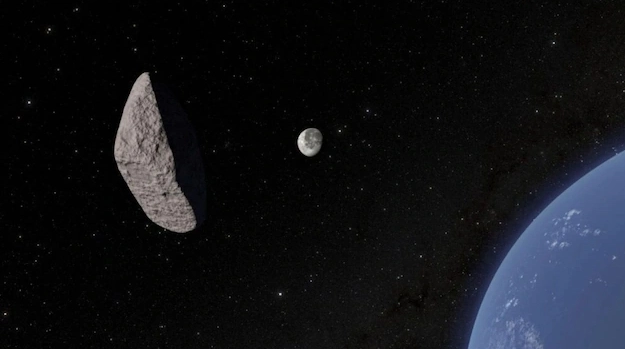
An asteroid nearly the size of three football fields is heading toward Earth for what astronomers are calling a “close approach", prompting heightened surveillance by NASA’s planetary defence teams. Named Asteroid 2003 MH4, this 335-metre-wide object is set to pass near Earth on May 24, 2025, travelling at a blistering speed of 14 kilometres per second – fast enough to cover the distance between Delhi and Mumbai in under a minute.
According to NASA’s Jet Propulsion Laboratory (JPL), the asteroid will come within 6.68 million kilometres of Earth. While that might sound comfortably distant in everyday terms, in the vast realm of space, it’s a narrow miss. NASA classifies any object over 150 metres wide and approaching within 7.5 million kilometres as a “Potentially Hazardous Asteroid". 2003 MH4 meets both criteria, making it a serious subject of scrutiny by scientists at the Centre for Near Earth Object Studies (CNEOS).
This massive space rock is part of the Apollo group, a class of Earth-crossing asteroids named after the first of their kind discovered in 1932. With over 21,000 known members, the Apollo group includes numerous objects whose orbital paths intersect with Earth’s, occasionally raising alarms about future impacts. NASA continues to track these celestial wanderers using a combination of ground-based telescopes and sophisticated computer models.
Although there is no imminent danger of 2003 MH4 striking Earth during this flyby, experts remain cautious. Its orbit, combined with its considerable size, warrants close monitoring. Scientists note that the asteroid completes a full orbit around the Sun every 410 days, increasing the chances of future close encounters. Should its trajectory shift, even slightly, due to gravitational interactions or other factors, future flybys could pose a greater risk.
This isn’t the only asteroid keeping scientists on their toes. Asteroid Apophis, once feared to impact Earth in 2029, has since been cleared of that risk after extensive observation. Meanwhile, other near-Earth objects like 2024 YR4 and 2025 FA22 remain under close study. Particularly, 2025 FA22 is expected to come uncomfortably close in the year 2089, though current models estimate the probability of collision at a mere 0.01%.
As May 24 approaches, scientists around the world will be watching 2003 MH4 closely; not because it poses an immediate threat, but because it reminds us of the precarious cosmic neighbourhood we inhabit.
-
'Did Not Do Anything Illegal': Ridhi Dogra Reveals Being Bullied For Working With Pak Actor Fawad Khan In Abir Gulaal & Speaking Against Film

-
Cops Stop French Man For Drunk Driving In Rhone, Only To Find He Drove Without Valid License Since 1997

-
DGFT notification on precious metal trade ensures consistency between customs duties and import regulations: GTRI

-
Taiwan's Foxconn says AI data centre with Nvidia to have 100 MW of power

-
US Senate confirms Trump nominee Charles Kushner to be ambassador to France
